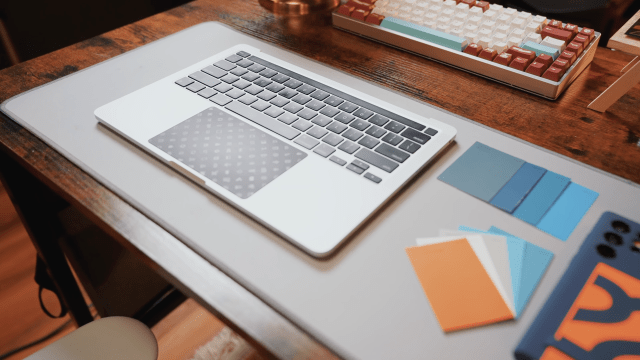Does this article’s headline sound a bit, we, unhinged to you? Why would anyone remove their MacBook’s display? Newer MacBooks have great displays, and if you didn’t want a display on your Mac, surely you’d have bought a Mac mini or a Mac Studio, right? But while it might seem silly indeed, removing a MacBook’s display is a practice that’s gaining some traction, and the idea isn’t without merit.
I admit the thought has occurred to me while using my MacBook Pro connected to an external display, with the laptop directly in front of me and the monitor directly behind the laptop. I liked being able to use my MacBook’s trackpad and keyboard on a larger screen, but I had to significantly raise the height of the monitor in order to avoid my MBP’s display blocking any of the larger screen’s real estate. It got me wondering: What if there were no MacBook display in the way? What if I had the same keyboard and trackpad setup in front of me, with a display at a normal height behind that?
It turns out that others have had similar thoughts — and put them into action. The Verge’s Umar Shakir recently wrote of his experience using a “decapitated” MacBook Air, which he dubbed a “slabtop.” He seems to have had a generally good time using his keyboard-trackpad-computer hybrid, connecting it to external displays both with a cable and wirelessly, taking the device along to parties, and using it to play Drawful.
In addition to providing you with a keyboard and trackpad, another fun advantage of this method is sound: Apple’s MacBooks, especially recent iterations, have much better speakers than those you’d find built into something like a Mac mini, meaning the slabtop is an ideal portable setup when you want something that literally sounds better than the competition.
There are other examples in the wild of people who have either removed their MacBook’s display or bought a device that had already been decapitated. Here are some use cases from Twitter:
More and more people are buying a MacBook Pro without a screen to use as a Mac mini. Not only does it have a trackpad and keyboard, but it also has better speakers, and the main price is particularly affordable. pic.twitter.com/WtxMQk1h8F
— DuanRui (@duanrui1205) March 7, 2022
Most of the time, removing a MacBook’s display doesn’t affect any of its processes. However, you’ll lose wifi on any MacBook with a wifi card embedded in the hinge of the display — but that design seems limited to MacBook Pros from 2008 through 2010. And since those models sport ethernet jacks, you’ll still have a way to connect to the internet.
But is it worth all the trouble? Removing the display doesn’t exactly enhance your Mac with extra features (and it takes away the one big feature that makes it a laptop). But going the “slabtop” route does give your machine a different vibe: Instead of the same laptop as everybody else, you have a futuristic Mac inside a keyboard and trackpad. You can plug it into a monitor during work hours, wirelessly connect it to a TV from your couch for comfortable computing or streaming, and just generally have something unique from most other Mac users.
A vibe probably isn’t enough of a reason to separate your perfectly-functioning MacBook from its perfectly-functioning display. I mean, you can, but I think the slabtop is better suited to specific contexts. If you break your display, for example, you might consider removing it altogether so you can still use the guts of the computer without paying to get it fixed or buying an external keyboard. If you’re in the market for a desktop, you could pick up a cheap but powerful MacBook with a broken display — the bad screen will drop the price considerably, even if the internals are solid.
How to remove your MacBook’s display
For Shakir, who removed the displays on his personal M1 MacBook Air as well as his cousin’s 2009 15-inch MacBook Pro, creating his slabtop wasn’t much of a problem. However, it helps that he used to be an Apple Store Genius and had already repaired more than 100 displays in his time there.
For the rest of us, exercising caution is important. If you want to go down this route, identify your model of MacBook and look up a reputable tutorial for removing the display. iFixit is my go-to for repair guides, so check to see if they have one for your specific model of MacBook, since the process definitely isn’t the same for all models. If you want to turn your M1 MacBook Air into a slabtop like Shakir did, you can follow the instructions in his article on The Verge.
If you can’t find a guide for your MacBook model or you prefer a video walkthrough, YouTube should be your next stop. Once you’ve found a video that looks like what you need, watch it through multiple times to make sure it seems legit and to get a grasp on the steps involved before you get to work.

Leave a Reply
You must be logged in to post a comment.